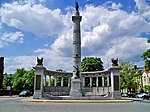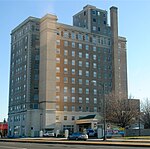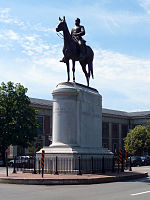Monument Avenue is a tree-lined grassy mall dividing the eastbound and westbound traffic in Richmond, Virginia, originally named for its emblematic complex of structures honoring those who fought for the Confederacy during the American Civil War. Between 1900 and 1925, Monument Avenue greatly expanded with architecturally significant houses, churches, and apartment buildings. Four of the bronze statues representing J. E. B. Stuart, Stonewall Jackson, Jefferson Davis and Matthew Fontaine Maury were removed from their memorial pedestals amidst civil unrest in July 2020. The Robert E. Lee monument was handled differently as it was owned by the Commonwealth, in contrast with the other monuments which were owned by the city. Dedicated in 1890, it was removed on September 8, 2021. All these monuments, including their pedestals, have now been removed completely from the Avenue. The last remaining statue on Monument Avenue is the Arthur Ashe Monument, memorializing the African-American tennis champion, dedicated in 1996.
In the wake of the protests that followed the murder of George Floyd in 2020, the Davis monument was torn down by protestors, while the Lee monument was ordered to be removed by Governor Ralph Northam. In July 2020, Richmond mayor Levar Stoney directed removal of the remaining Confederate monuments on city-owned land including J.E.B. Stuart, Stonewall Jackson, Matthew Fontaine Maury, the cannons marking the Richmond Defenses, and other monuments around the Richmond area.
Monument Avenue is the site of several annual events, particularly in the spring, including an annual Monument Avenue 10K race and "Easter on Parade", when many Richmonders stroll the avenue wearing Easter bonnets and other finery. Prior to 2020, at various times (such as Robert E. Lee's birthday and Confederate History Month), the Sons of Confederate Veterans gathered along Monument Avenue in period military costumes.
"Monument Avenue Historic District" includes the part of Monument Avenue beginning at the traffic circle in the east at the intersection of West Franklin Street and North Lombardy Street, extending westward for some fourteen blocks to Roseneath Avenue, and is listed on the National Register of Historic Places as a National Historic Landmark District.The American Planning Association selected Monument Avenue as one of the "10 Great Streets in America for 2007" based upon the corridor's historical residential design and craftsmanship, diversity of land uses, the integration of multiple forms of transportation, and the commitment of the community to preserve its legacy.








